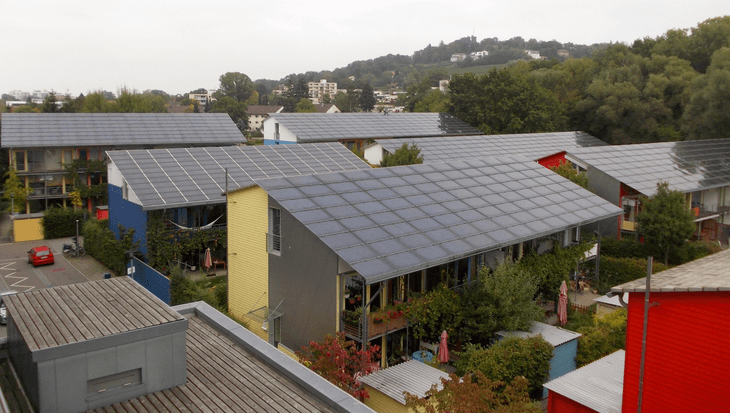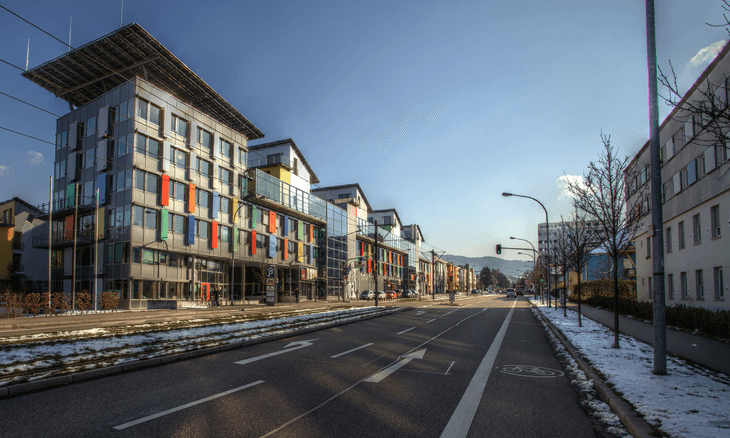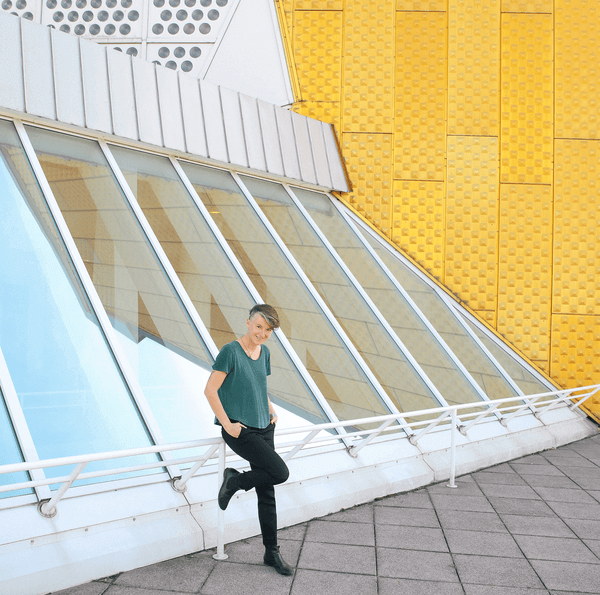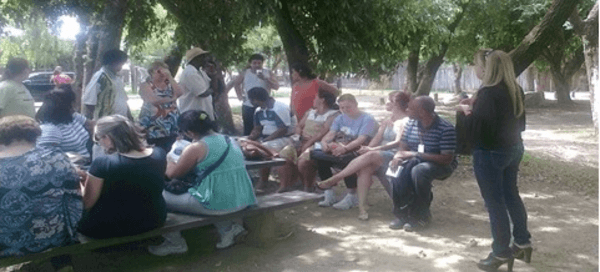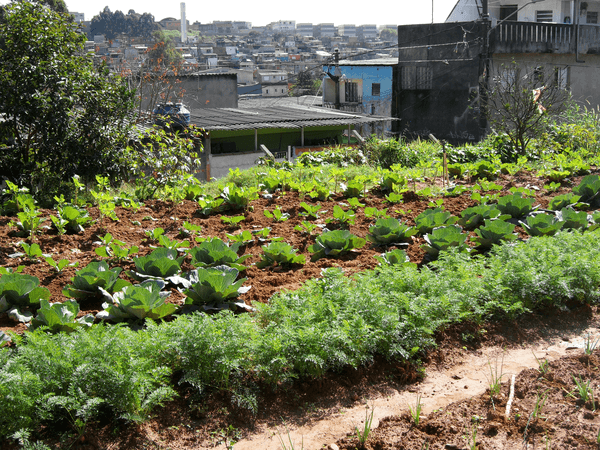A former derelict site is developed into a residential district through an integrated approach
The district Vauban is known as a model for a sustainable ecological collectively planned urban district. In 1996 it was chosen as a best practices project at the UN habitat conference in Istanbul.
On the area of an old military base a whole new district with a lot of housing spaces was be built with the participation of the citizens. The City of Freiburg responsible for the planning and development of the district-project cooperated with an extended citizen participation organized by an association called Forum Vauban.
Under guiding principles concerning different high ecological standards different environmental projects such as a co-building group and a car reducing traffic system began in 1996. The city gave away land at the start of the building phase.
Nowadays nearly 5000 people live in Vauban a nearly car-free, low-energy, social integrating, and sustainable neighbourhood full of playgrounds, and its own kindergarten.
Dubai International Award for Best Practices
This project was awarded the 'Dubai International Award for Best Practices' in 2002.
In the early nineties a serious shortage of housing areas in Freiburg led to house building projects and the creation of living quarters. The main objection was thereby to build high quality living spaces especially for young families, students, and elder people within city borders. So from the very beginning further infrastructure like primary schools, a new railway line, and green spaces were part of the building plan. Even a dense urban design concept including a low energy standard for all build houses was defined.
The target group(s) should also be involved in the planning and building process. The idea was to develop collective a new district under the attention of ecological criteria. The sustainable city district could then become a model for further similar initiatives.
The association/NGO “Forum Vauban,” founded in 1994, was involved each step of the way. The NGO developed and added more concrete objectives thought its participation. A specific traffic concept was designed including a car-free approach and alternative mobility. Additionally, the promotion and support of co-building groups and the design of special areas for passive-houses (very low energy houses) and the existence of a central market place and a community centre.
The district Vauban was used as an army base since the 1930s, at last by the French army. With the peace treaty in 1991 the French army closed the base. The area, which was property of the German government, could be activated for civilian use. The City of Freiburg had bought the whole area for 40Million German Mark (20Million Euro) and announced a competition for urban planners in 1993 to use the area as a new living area. The architect-office Kohlhoff from Stuttgart won the competition. The building plan included a free frame in which the possibility of sustaining the old caserns was given as an option.
Right from the beginning in 1994, an NGO was founded by involved citizens. The NGO, named Form Vauban, participated in the progress of developing and planning the new district. Other actors were the Project Group Vauban (the administrative coordination of the local authorities dealing with the Vauban project) and the City Council Vauban Committee (the main platform for the information exchange, discussion and decision preparation in the City Council). Even if the decisions were ultimately made by the city council. In this Vauban committee, representatives from political parties discussed the main Vauban issues together with representatives from the administration and further consultative members such as Forum Vauban.
With the help of experts’ knowledge in the meetings of the Forum Vauban, the ideas and basic principles for the new district were developed. These five principles were: a car-reduced traffic concept, a social mixture in the district, a preference of private co-building groups and cooperative self-help models, short-ways concept of the infrastructure, and an ecological local heating concept.
Meetings between Forum Vauban and members of the city administration took place regularly. If necessary, further common initiatives such as round tables and workshops were organized (for example for the planning of the open green spaces).
All participants agreed on some moderate regulations. They comprised of a fixed height on the houses, greening of facades and roofs, and regulations concerning rainwater filtration.
In July 1996, a project-exchange for co-building groups and associations was discovered. One year later the zoning map was designed and pieces of land were given away to particular house builders. In April 1998, the building phase began.
In general commercial investors were restricted to some limited areas of the building site. The formation of co-building groups provided a specific structure and identity within the community, and made it quite easy to get in contact with the people.
Further special committees were founded which collaborated with other establishments like the city‘s welfare institutions for the social work within the new district. The social work includes offers for specific target groups like children, youth, or families and the initiation and support of grassroots-initiatives or conflict management.
The Forum Vauban which organised the main part of the advanced public participation in the district Vauban existed until 2004. It declared insolvency caused by a claim for the return of financial support from the EU. The predecessor association is called “Stadtteilverein Vauban e.V.” and adopted the whole field of functions.
Personal or “human resources” played a huge role in this project. The NGO “Forum Vauban” was founded on ideas and dreams of seven people in the beginning and grew quickly, after two months to 60 members. During the building process, (2003) it grew to 400 members. Each member participated with personal capital or personal credit. Nowadays the Forum Vauban has a fixed income financed each year through membership fees.
In the task group of the local council the Forum Vauban had a fixed seat and get the financial support of 40,000 German Marks (20,000Euro) a year from the City of Freiburg. A publicity campaign in 1995 called “living-spring” financed by the City of Freiburg with 30,000 German Marks brought the project much needed attention and mobilized most of the future inhabitants. Further financial support came in 1995 from the German Environment Foundation (Deutsche Bundesstiftung Umwelt, DBU) with 160,000 German Marks (80,000Euro) and in 1997 from the European LIFE-program with 1.4Million German Marks (700,000Euro).
The house builders and co-building groups received the usual support and tax reductions granted by the Federal Republic of Germany and the Federal State of Baden-Wurttemberg.
A new attractive district especially for young families was constructed and developed. In 2002 more than 20% of Vauban inhabitants were under 10 years old. The demand for land was stronger than availability.
Participatory planning during the building stage was a great success. Legal, political, social, and economic participants were integrated from a small grassroots level up to the city administration.
Concrete objectives were achieved or exceeded. All houses were built with improved low energy standard, 65 kWh/m2a similar to the Swiss SIA380/1 standard. Around 150 houses will be "passive house" (15 kWh/m2a) or "plus energy house" standard, producing more energy than they use.
A highly efficient co-generation plant (CHP) operating with wood-chips is connected to the district's heating grid. Good insulation and efficient heat supply creates CO²-savings of 60%. A large number of solar collectors and photovoltaic modules were installed. Around 65% of the electricity needed in Vauban is produced on-site through CHP and photovoltaic.
The ecological traffic concept reduced the number of private cars, provided good public transportation, and a car sharing system. Streets and other public spaces became playgrounds for children or other public uses.
Rainwater is collected separately for in-house use or filtrated into the ground. A new sanitary concept using vacuum toilets and biogas plants was introduced by one co-building group.
About 40 co-housing groups were established alongside building cooperatives and the self-organized S.U.S.I.-settlement initiative. These initiatives enabled holistic public participation.
During the entire building and planning phase, a few small conflicts occurred. Among other things like the huge commitment of the participating citizens, this is due to the seasoned architects involved in the process.
The district is mostly composed of young people and young families. Around 2000 adolescents live in the area. The inhabitants are fairly homogeneous, yet so many young people create an unbalanced age structure.
Another barrier is the lack of private space in the district. The area is filled with playgrounds, and lacks a clam environment.
The Forum Vauban was the official body for participation. The project benefitted from Form Vauban’s creative ideas and legal expertise. Without a real participation progress, the wonderful ideas from civil society would have fallen on the deaf ears of politicians. Form Vauban enabled good cooperation between the politicians and civil-society necessary to find the best common solution. The participatory processes experienced unequivocal success because it started right at the beginning.
The “development site status” enabled the district to stay independent from private developers, and take responsibility for the entire planning and building progress.
For a local organisation like Form Vauban, the handling of finances was an overwhelming responsibility. More funding resources for small independent groups are needed, to avoid delayed payments and putting the liquidity of the project in danger. Additionally, “recycling” of old military bases or industrial areas could slow down sub-urbanisation.
The experiences of the Vauban project and Form Vauban were shared in a handbook and congress titled “Urban Vision” organised by the LIFE-programme of the European Commission and the Institute for Applied Ecology. The Vauban associations organised many knowledge-transfer workshops over Germany and in Japan. The Vauban association also offers tours of the area and takes part in other planning projects.
A company founded by Forum Vauban members called “Buergerbau AG” advises similar projects in other German Cities and manages co-building groups.
Vauban was presented as a Best Practice at the 1996 UN Habitat II conference in Istanbul, and was a finalist of the Partnership Award at the "Business and Municipality" conference in Bremen 2001.
The Vauban project benefited from the experience of other projects such as: the conversion of an old army base into a mixed commercial and housing area in “Tübingen-Südstadt” and the failed car-free project in Bremen-Hollerland showed possible obstacles, and helped avoid mistakes.
Official website Vauban (in English, German, French and Italian):
http://www.vauban.de/info/geschichte.html
Information on Freiburg's offical website
http://www.freiburg.de/pb/,Lde/208732.html?QUERYSTRING=vauban (german)
